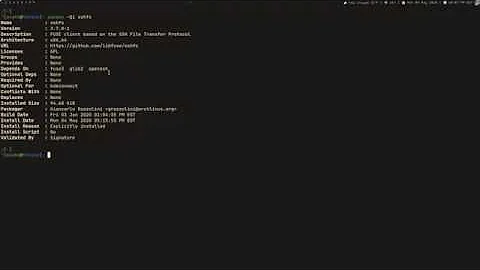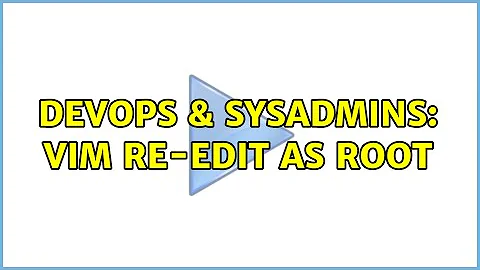vim re-edit as root
Solution 1
From this stackoverflow answer, by skinp
:w !sudo tee %I often forget to sudo before editing a file I don't have write permissions on. When I come to save that file and get a permission error, I just issue that vim command in order to save the file without the need to save it to a temp file and then copy it back again.
Solution 2
Please do not vote me down for this. I do not recommend implementing this answer, but it is the answer that the rkthkr is asking for.
rkthkr said:
But it would be nice to have vim restarted and run as root
The way to do this is with :!sudo vim %
As I mentioned to ipozgaj, a % as an argument (even a sub-argument) gets replaced with the path to the current buffer. (You may get prompted for your password.) You end up with a new vim process, owned by root, that is a child process of the original vim process. Sounds goofy, right? Here is what it looks like in ps:
~# ps afo pid,ppid,user,stat,comm
PID PPID USER STAT COMMAND
16187 30478 rbronosky Ss bash
16510 16187 rbronosky R+ \_ ps
30482 30478 rbronosky Ss bash
16244 30482 rbronosky S+ \_ vim
16318 16244 root S+ \_ vim
If you have write permissions to the directory that contains the file and you have made edits to it, you may get warned that a swap file exits. Choosing to [R]ecover, will reflect most* of the changes made by the parent vim process. (*I think maybe the swap update is timed or has a delta threshold. I've put too much time into this already and do not care to research it.) When you go and quit vim, don't be alarmed when you are still in vim... you opened a 2nd vim process. Remember?
Now, with all of that said... I would almost never do this. Maybe, if I have had not enough or way too much coffee, and I realized that I was going to need to edit several more files as root... I might try this. In 14 years of administering systems, I never have. But, until you expressed discontent with my preferred solution (which is exactly as dbr offered) I had never thought about this.
Solution 3
I usually save it to a temporary file in $HOME/tmp/apache.conf (for example) then
sudo vimdiff $HOME/tmp/apache.conf /etc/apache2/apache.conf
this is some extra work to merge the changes but it paid off. I find it to be a nice way between convenience and measurements against unwanted changes
Before that I was thinking of ACLs or assigning corresponding groups to the files but it didn't work out all to often I either forgot to change the ownerships or was changing files where I didn't mean to do so.
That goes only for files which aren't managed until now. The overall solution we use is puppet with a git repo where people locally edit files and test the changes on appropriate servers, if the configuration works as desired the changes are pushed back to the central repository where our configuration engine pulls changes at regular intervalls.
Related videos on Youtube
rkthkr
I got very little time for serverfault nowadays... A Free Software programmer, Systems Engineer, Administrator, Scuba Diver, Husband, Father of two and a born again Rocketeer
Updated on September 17, 2022Comments
-
rkthkr over 1 year
I often open a file in vim, make some changes and when it's time to save the file is read-only.. (owned by another user). I'm looking for tips on how I could re-open the file as root and keep my changes without first saving it to a temporary file for copy or re-edit as root.
-
rkthkr almost 15 yearsThat is almost it.. But it would be nice to have vim restarted and run as root.. This is my favorite so far :)
-
Bruno Bronosky almost 15 years@rkthkr, if "vim restarted and run as root" you would be unable to save any edits you have made, and lose your undo history. But if that is what you want... [Ran out of characters.] See the "answer" I'm about to write.
-
Bruno Bronosky almost 15 years@dbr, I think it is worth mentioning that after you overwrite the file (with tee as sudo), you will get prompted with [O]k or [L]oad. The later option will erase your undo history an reset the "modified flag" allowing you to exit without being warned to save changes. The former option, which I prefer, will preserve your undo history, but will cause you to get warned when you try to quit. You have to use :q! to quit in this case. I do this so I can validate (e.g. :!sudo /etc/init.d/httpd configtest) and rollback/reedit if I need to.
-
rkthkr almost 15 yearsThanks Richard! Very informative, I'll give you +1 for it :)
-
Mei almost 15 yearsThis is a very high-quality answer: why vote down? +1 from me too.
-
 FabricatedSavant almost 13 yearsThanks @Richard Bronosky, in my gvim is not possible to type the sudo password with
FabricatedSavant almost 13 yearsThanks @Richard Bronosky, in my gvim is not possible to type the sudo password with:w !sudo tee %so I think this is a good answer.




